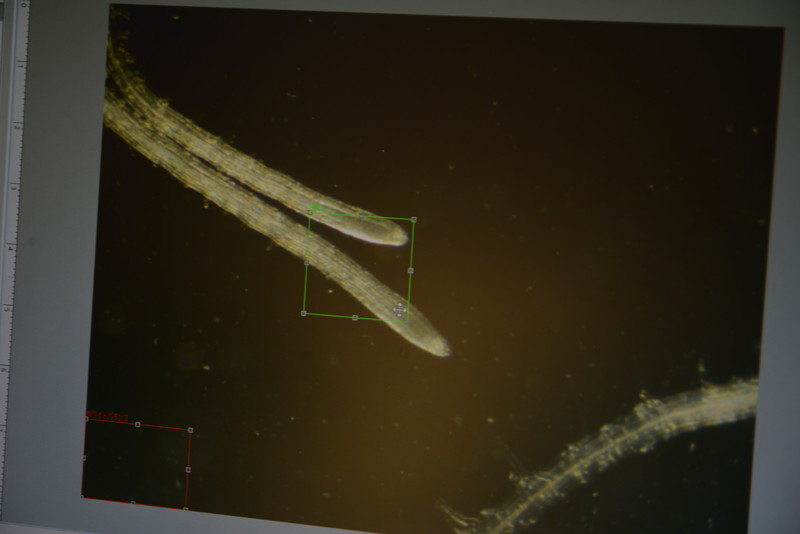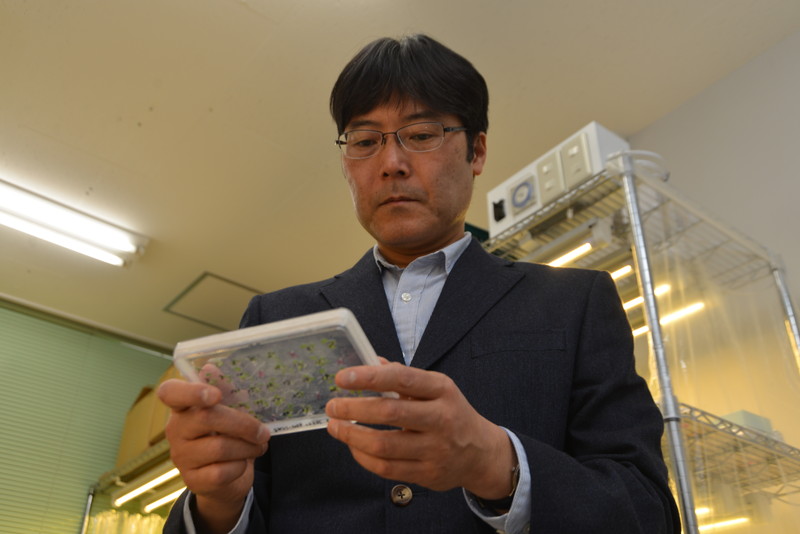NEWS
IROAST Researchers - Prof. Mitsuhiro Aida
English Japanese
Genetic research reveals the mechanism of “how plants grow and change their shape”

Prof. Mitsuhiro AIDA
International Research Organization for Advanced Science and Technology (IROAST)
(Period at IROAST: from July 2017)
Starting from a small seed, the plant grows and produces flowers and fruit that are specific to each type of plant. Professor Mitsuhiro Aida is attempting to unravel this process by studying the actions of genes. His basic research that seeks to understand the mechanism underlying plant growth and development may also lead to applications such as improvement of agricultural products.
■ The “mysterious shape” of plants: Seeking the reason.
Q: Please first tell us about the content of your research.
Aida: My field of research is plant developmental biology, which investigates the mechanism of how plants grow and make their body. When germinate, plants are very small and consist only of a few parts. After a while, they sprout new leaves, grow steadily, and finally produce flowers and bear fruit. The final shape of the plant is remarkably different from what it originally was, and their shape varies depending on the kind of plants and environmental conditions. My research is to clarify how that mechanism works by looking at genes. The origin of the stems, leaves, and flowers above ground are the tips of the stems. How are these parts made in the plant?
Discovering the various genes involved in this process and their function may reveal the mechanism that makes important parts for growth at the beginning of a plant’s life.

Q: What kind of plants are you studying?
Aida: I mainly use a small weed called Arabidopsis thaliana, or thale cress, which is suitable for studying gene functions thanks to its small size, fast growth, and relatively simple genetic information. Indeed, you can easily grow this plant in a laboratory without spending space too much.
There are familiar vegetables in the same group as Arabidopsis thaliana, including cabbage, broccoli, cauliflower, and rape blossoms. In broccoli, for example, flowers stay immature as small buds and cauliflower makes white clusters instead of flowers. Such traits make it easier to eat these plants as vegetables. Until now, these plants have been bred through selective breeding over a long period of time while also relying on chance. However, if we know genes that are responsible for useful traits and understand how they work, such knowledge would provide ways to control plant traits more efficiently and may make it possible, for example, to increase crop yields or to create plants that are more resistant to disease and resilient against harsh environment. My research is basic, but I expect that it will also lead to this type of applied research.
Q: Why did you start in this kind of research?
Aida: I have liked to visit museums ever since I was a child, and I began to be interested in the mysteriousness of “shape” when I saw various specimens of living things and dinosaur fossils. When I was moving onto graduate studies, genetic research on plants, which had been very difficult up to that point, experienced an explosive leap with the introduction of the plant Arabidopsis thaliana. The reason is that it has relatively a small number of genes compared to other plant species, and individual genes are easier to extract and manipulate. The mechanisms are common to other plants, so if we could understand the genetic mechanism of Arabidopsis thaliana, it would also be useful for research of other plants. This trend started in the 1990s, which is around the same time that I started research.

■ The experience of producing results within a limited time in a place like IROAST, is also valuable
Q: What brought you to IROAST?
Aida:I was nearing the end of my term at the research organization I was with at the time, and I heard about IROAST recruiting researchers just as I was looking for my next opportunity. It was very appealing because IROAST was offering a tenure track with the support of research funding and I could undertake research as part of a team if I met the prescribed conditions, as one researcher with expert knowledge would be assigned to the research. IROAST also has researchers from a wide range of fields, mainly in the field of engineering, which drew me to different areas from the bioscience-specific environment to which I previously belonged.
What I really noticed when I arrived was the good balance. It was very interesting to hear from researchers in completely different fields, and even researchers in the same field as mine had different research techniques, so that was where collaborative research began. Even outside IROAST, for example, researchers from the Faculty of Science had common techniques despite studying different plants, so there were occasions where the research progressed through skillful combination with my technology.
Although the foundation cultivated up to that point is important for research technology, combining the existing technology with mathematics, chemistry, or information science can generate new technologies. In that respect, the good balance at IROAST and Kumamoto University has a positive effect on research.
Q: What about international research?
Aida:IROAST proactively promotes exchange by concluding agreements with overseas universities and research institutes. There are also projects where it is a prerequisite to collaborate with overseas researchers, and IROAST having and supporting overseas ties is a great advantage. I too have conducted joint research with researchers in fields of research I previously had little interaction with, and have produced good results.
Q: What is your message to students and young researchers?
Aida:If you think that the “research looks interesting,” please jump in. I too was hesitant at first, but when I looked at a plant under a microscope I was fascinated by its beauty. I am glad I am able to conduct research to understand how this beauty is made. If you look closely at something you want to know and ask questions, some hint will come back to you. Don’t miss this chance. It is good to be able to experience the enjoyment of discovering these hints. Also, even if you do not advance into the world of research, I want you to know that research itself is a part of supporting society.
IROAST is a great environment where young researchers can concentrate on their studies. Universities are educational institutions, so normally time is taken away for education and administrative work. However, at IROAST, that time is minimized, and support is provided to enable young researchers to devote as much time as possible to their research. Apart from the motivation of “I want to know this,” in the tenure track system deadlines for results are set at different intervals, and these conditions also accelerate research. As a researcher, I think it would be good to place yourself in an environment like IROAST.

リンク
- Research Fields
- Plant Developmental Biology|Aida Lab.
- Researchmap
- Researchgate

